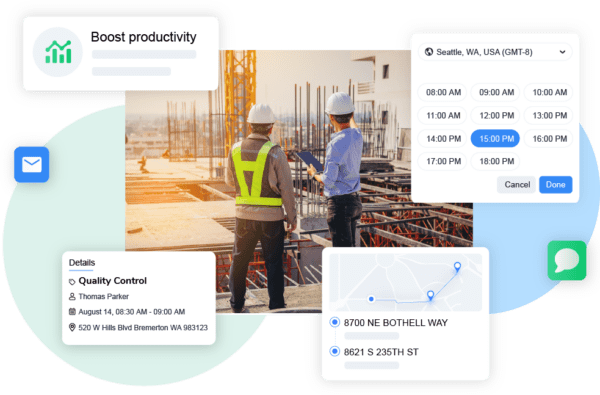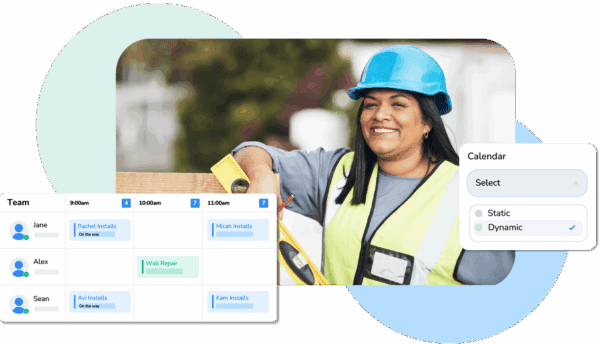
What happens when a construction crew shows up at the wrong address? The cost immediately translates into a truck roll, an hour of labor, and a client who starts to doubt your reliability. When the people on the ground and the people in the office aren’t looking at the same information, your operations constantly run into gaps that cost you big. The numbers give an idea of how serious these costs are.
The Construction Industry Institute says every month of delay adds roughly 8% to total costs. When nearly 35% of residential projects already run late, and many owners report routine delays, those percentages compound fast.
Job tracking software is the practical tool that closes the gap between the people in the field and the office. It timestamps events, locks documents to a job, routes crews intelligently, and feeds what happened straight into billing so the business stops paying for its own mistakes. It doesn’t remove every problem, but it does the one thing most jobs need:
“It keeps the field and office in sync. ”
Below, we break down why job tracking matters, exactly which features change outcomes, when to pick Arrivy, and how to run a pilot that proves value fast.
Recommended Reads
Why Construction Job Tracking Matters
We can say “better communication” and sound like every marketing page, or we can look at problems:
Real Business Problems
- Crews idle because parts are late
- Supervisors can’t prove when a job started and stopped
- Billing teams rebuild invoices from scratch
Those are the loopholes that drain profit. The construction sector’s productivity gains have been modest, and when almost half of firms still use little to no software for labor and field operations, that’s a lot of wasted time and preventable error.
“Job tracking puts a living record on every job so decisions are based on facts.”
Common challenges in managing construction projects
Most problems on the job come down to poor visibility. If the foreman still needs to walk back to the trailer to find a phone and someone to call, he can’t tell the scheduler that the roofers will be two hours late because the shingles truck stalled on the highway. The office can’t reassign the drywall crew if they don’t know a sub is stuck. When a company uses spreadsheets and the occasional texts to manage day-of work, updates are slow and mistakes multiply easily.
The worst-case cost of doing nothing
If you keep running jobs from memory and a paper folder, errors are obvious and almost impossible to avoid. You end up having missed handoffs, which means rework, more labor hours, and delayed billing. Clients get annoyed because they see a crew show up late or not at all, and customer frustration is expensive, as almost everyone says service quality affects their buying decisions and loyalty with a business. Weak or inconsistent communication alone costs businesses heavily each year. For contractors, the measurable losses from delays and poor communication are direct hits against your profit percentage on each job.
How job tracking creates transparency and accountability
Good job tracking software makes the workday visible. It timestamps when crews start and finish tasks, attaches photos of work done, and keeps all permits and proposals tied to the job. A single job record that holds the schedule, photos, forms, and signatures is the simplest kind of accountability you can buy. Foremen know what’s required, dispatchers know who’s running late, and billing knows what to invoice. When the office and field share the same live view, you stop paying for avoidable errors.
Key Features to Look for in Construction Job Tracking Software
When you evaluate systems, don’t shop on shiny features alone. Think about how the tool helps you fix day-of execution problems. Can it stop a mis-scheduled crew before they drive across town? Can it attach the correct permit to a job so inspection passes don’t get delayed? Here are the specific capabilities that matter.

Task scheduling & assignment
You want a scheduler that shows the whole week at a glance and lets you assign tasks to crews. Drag-and-drop scheduling with conflict checking prevents the embarrassing double-book where two crews show up at the same address. Rules that enforce skill matches and required prep times reduce last-minute surprises. For example, flagging that a crane is needed and not letting the work go live until it’s scheduled. Arrivy’s visual scheduling and dispatch console are built to reduce these day-of conflicts and make re-sequencing straightforward.
Real-time crew tracking (field vs. office visibility)
If the office can see where crews are in real time, they don’t have to call them for updates. Live tracking lets dispatchers reroute the nearest crew when a delay appears, or push a customer an accurate arrival window rather than a vague “in the evening today.” That visibility prevents wasted labor when, instead of calling multiple people to track someone down, a manager can look at a map and make a fast decision. Arrivy provides GPS-enabled, live crew location and job status so the office and field share the same view.
Mobile apps for crews on-site
A mobile app should let crews tap a single button to indicate they’re en route, start a job, capture photos, collect signatures, and close a task, all with offline support so the tool doesn’t break when cell service is unavailable. The less friction you put between the crew and the update, the more accurate your job records become. Arrivy’s mobile app is built for field capture, including clock-in/out, photo and note capture, and status changes that update the office in real time.
Document & proposal management (tie-in: roofing proposal template)
Attach permits, forms, surveys, and the right proposal to the job record so everyone sees the same scope. For example, for roofing crews, that means the estimator’s template, aerial measurements, warranty docs, and the signed proposal all live on the job so the crew can answer scope questions on site and the billing team can invoice without reconciling three different files. Keeping documents tied to the job record reduces disputes and speeds approvals. With Arrivy’s pre- and custom-built digital forms and survey templates, crews can fill in information right from the app without having to switch tools or use paper forms.
Reporting & analytics for project progress
A dashboard that only looks promising is useless. The reporting you need will show recurring trouble spots, like which task types repeatedly run late, which crews have the highest travel time, and how long approvals or materials cause upstream delays. Use those reports to change processes. For example, re-sequencing tasks that regularly delay a job, or shifting crew assignments where utilization is low.
Route optimization and multi-stop planning
If your crews have multiple stops, you need route planning that understands live traffic and multi-stop optimization so everyone spends less time driving and more time doing the actual work. Route optimization reduces fuel costs and increases the number of billable tasks a crew can complete in a day. Arrivy includes route planning and traffic-aware optimization so you can set efficient multi-stop days for your crews.

Best Construction Job Tracking Software in 2025
Rather than a top-ten list, think in terms of real needs:
- Speed and simplicity for small crews
- Coordination and analytics for growing contractors
- Integrations and central control for large firms
For many mid-sized and scaling construction firms, Arrivy lands in the “sweet spot” because it combines scheduling, live tracking, mobile capture, forms, routing, and integrations into one platform. This package is useful when you need to shrink the gap between job completion and getting paid.
Arrivy – Best Fit for Task + Crew Coordination
Pick Arrivy when your day-of operations are the choke point; when crews show up late, customer promises slip, or your billing team spends hours making sense of field notes. Arrivy combines a dispatch console, visual scheduler, mobile field app, route optimization, and digital forms, which reduces the number of separate tools your team must use and minimizes double entry. If you also care about getting invoices out quickly without manual transcription, Arrivy’s QuickBooks integration pushes line items collected in the field straight into your accounting system. That reduces “swivel chair” data entry and shortens your cash cycle.
When to choose Arrivy in practical terms
- If your office spends its mornings calling crews to confirm times and your afternoons reconciling what was actually done, Arrivy’s live status and field capture reduce that churn.
- If you run multi-stop days and want fewer miles and more billable hours, Arrivy’s route optimization helps with sensible multi-stop sequencing.
- If finance spends hours building invoices from field notes, the QuickBooks sync removes a manual step and reduces entry errors.
Transparent, Flexible Pricing for Construction Teams
Arrivy’s Standard Plan starts at just $75/month for 3 full-access users (plus 2X limited-access users). Add more full-access users anytime for only $25/month per user.
Every plan includes powerful features:
- ✅ Team Scheduling & Dispatch
- ✅ Customer & Crew Experience
- ✅ SMS & Email Notifications
- ✅ Reporting & Analytics
How Job Tracking Software Improves Task & Team Monitoring
Real-time visibility of who’s doing what
When the office sees that a crew hasn’t started a task at the scheduled time, dispatch can intervene immediately. They can call the crew, reroute resources, or reassign a local crew to cover critical work. The earlier you find the delay, the cheaper it is to fix.
Better communication between field crews & office managers
Replace the back-and-forth phone tag with a single stream of updates. Photos from the crew, timestamped notes, and quick status buttons keep everyone aligned. This matters when subcontractors arrive and need direction, or when you need to prove scope changes to a client.
Automated updates to reduce manual follow-ups
Automatic arrival notices and completion alerts reduce time spent chasing updates. Customers get accurate ETAs instead of vague windows, and supervisors get notified of exceptions before they ripple into other jobs. That alone cuts admin time dramatically.
Digital record-keeping for compliance & proposals
Keep permits, photos, and signed proposals attached to the job. When inspectors show up, pull the file on a tablet. When a homeowner disputes a charge, show the signed proposal and the job photos. Digital records make disputes resolvable in minutes instead of days.

Choosing the Right Software for Your Construction Business
Small vs. mid vs. large contractors
Small Contractors
Usually, they need low friction above all else, preferably a tool that sets up quickly, runs on mobile devices, and requires little training for crews who are already stretched thin. They can’t afford months of onboarding or software that demands a full-time admin to manage it. The right fit is something that handles scheduling, updates, and invoicing without burying them in features they won’t use.
Mid-Sized Contractors
They sit in the tricky middle. They’ve outgrown spreadsheets and text chains, but they’re not running massive project portfolios across multiple states. What they need is strong coordination with real-time crew tracking, document capture in the field, and reporting that shows which jobs are profitable. Integrations with accounting tools like QuickBooks become important here because delays in billing or payroll quickly hit cash flow.
Large Contractors
They operate at another level. They need centralized reporting that works across multiple divisions or sites, role-based access to control who sees what, and integrations deep enough to connect with payroll, ERP, and project management platforms. For them, scalability, compliance, and cross-site visibility matter as much as day-to-day scheduling.
If you’re small today but expect to scale, it’s worth picking software with a clear enterprise path so you don’t face a painful rip-and-replace later.
Importance of integrations (QuickBooks, CRM, ERP)
Integrations remove manual steps and reduce errors. Sending field-captured line items directly to QuickBooks shortens billing cycles and cuts mistakes. Arrivy supports QuickBooks and a range of CRM/ERP integrations, which means your entire operation is connected from initial lead capture to final invoicing and customer review. For teams where finance waits on field notes, that integration is worth the price of the software in time saved.
Trial/demo vs. full deployment
Always pilot on a representative job type. Use the pilot to test scheduling behavior, mobile capture in low-signal areas, and the integration with accounting. Measure the time saved on billing and the reduction in phone calls during the pilot. Those simple metrics will tell you whether the tool is worth deploying operation-wide.
Wrap-up and practical next steps
If your business still depends on paper notes, multiple spreadsheets, or a mix of scattered tools, you’re paying for the inefficiencies every day. The Field Service Management market is growing because teams that get control of day-of operations see measurable improvements in utilization and cash flow. Start by piloting with the type of job that costs you the most in delays (maybe roofing or a typical multi-stop service day) and track three KPIs:
- • Average crew drive time
- • Time from job completion to invoice
- • Number of phone calls per day about job status
- • Incidents of rework or schedule changes mid-day
- • Daily labor utilization rate (how much of paid hours are spent on billable work vs. waiting or paperwork)
If those numbers improve in the pilot, you have your ROI.
If you want software that helps you schedule, dispatch, capture field work, optimize routes, and push jobs to QuickBooks without rebuilding your workflow, Arrivy is built to do exactly that and to scale from small crews to multi-site operations. Stop struggling with paper and spreadsheets.
Frequently Asked Question
It’s a system that connects scheduling, field updates, crew locations, documents, and billing so offices and sites operate from the same live information.
By showing assignments, locations, and statuses in real time. Dispatchers can reroute crews, managers can see utilization, and foremen can offload paperwork to the app.
Yes. The best systems, like Arrivy, combine or integrate scheduling, routing, and dispatch so the calendar is the single source of truth.
Project management handles long-term planning and budgets. Job tracking focuses on day-of execution by providing robust dispatching, crew status, field capture, and quick invoicing features.
Yes. Look for a solution with a fast onboarding path and simple mobile UX so crews adopt it quickly.
By centralizing updates, automating customer and crew notifications, and making it easy to attach photos and proof to a job, so decisions are faster and disputes smaller.
Yes, Arrivy lets you attach templates and push final items from the job into accounting for invoicing.
Pick one that supports start/stop times, photo and signature capture, offline work, and integrates with your back-office tools. For teams wanting scheduling, live tracking, digital forms, route optimization, and QuickBooks sync in a single platform, Arrivy is worth evaluating.
